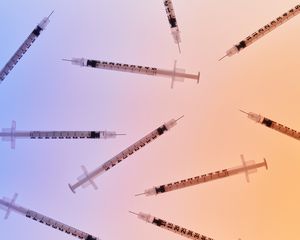
ohlamour studio / Stocksy
Suffice it to say, the plumped pout aesthetic is certainly having a moment—and one we don’t anticipate ending anytime soon. Lip fillers are such a popular treatment that one study cited that the demand for soft lip fillers has gone up almost 312 percent since the year 2000.
So it comes as no surprise that more permanent options have been getting increased attention in recent years. This poses the obvious question: Is there such a thing as permanent lip filler, or are lip implants the only truly permanent option available? The answer is involved, to say the least. That’s why we spoke to plastic surgeon Dara Liotta, MD; nurse practitioner Roberta Moradfar, MSN; and dermatologist Rachel Maiman, MD, who outlined a few of the permanent and longer-lasting lip augmentation options, offered details on each treatment, and provided guidelines for determining if you’re a good candidate. Keep reading to learn more.
Meet the Expert
- Dara Liotta, MD, is a board-certified facial plastic and reconstructive surgeon. She runs her own practice on New York City’s Upper East Side.
- Roberta Moradfar, MSN, is a board-certified nurse practitioner and owner of the Los Angeles-based EFFACÈ Aesthetics clinic.
- Rachel Maiman, MD, is a board-certified general and cosmetic dermatologist who practices at New York City’s Marmur Medical.
What Are Some Longer-Lasting or Permanent Lip Filler Options?
Want a plumper pout that won’t quit? According to our three experts, the below options are some of the most common.
Longer-Lasting Filler
While the popular hyaluronic acid-based fillers like Juvederm and Restylane can last anywhere from six to 12 months, certain fillers can last even longer. “Vollure, which is a Juvederm product, has been shown to last up to 18 months due to its 'vycross' technology, which consists of both low and high molecular weights of hyaluronic acid, resulting in a highly cross-linked formula that makes it more difficult for the body to break down,” says Moradfar. “Using Vollure in the lips is considered an 'off-label' treatment—meaning, the treatment is being used differently than what it's marketed for and outside the indications of FDA approval. However, these practices are not only common but generally safe as long as the practitioner uses their discretion and finds that this filler choice is better suited to meet the needs of their patient.”
Additionally, Restylane KYSSE, Juvederm Ultra XC, and Juvederm Volbella have been shown to last up to a year, Maiman says. “Before hyaluronic acid fillers became popular, the 'go-to' fillers for permanent lip enhancements used to be collagen-based, like Artefill. However, while some providers still perform these injections, they have largely fallen out of favor,” she says. “This is due to a higher risk of adverse events that are statistically more likely to be long-lasting, like lumps or nodules, inflammatory reactions, scarring, prolonged redness, and a higher risk of allergic reactions.”
Fat Transfer
A fat transfer treatment requires taking small droplets of fat from another part of the body (usually the abdomen or thighs) and transferring said fat into the lips using a cannula needle, not unlike the method of injecting a filler. “Not all transferred fat will take up a new blood supply and live in the new environment, so augmentation with fat transfer is a little of an educated guessing game, and getting a long-lasting, even result can require multiple sessions over the course of months,” says Liotta.
Lip Implants
“Lip implants are a permanent solution that tends to increase in popularity every year. They involve the use of soft plastic implants, such as silicone and expanded polytetrafluoroethylene,” Maiman says. “This approach is really only recommended for those who have symmetrical lips at baseline and sufficient lip tissue to stretch over the implant and conceal it for natural-looking results.”
Additionally, lip lift surgery is also an option, but according to Liotta, it isn’t a true lip augmentation surgery. “A lip lift surgery involves removing the skin above the lip and physically rolling the red lip area upwards to increase its height and decrease the distance between the nose and lip,” she says. “It does increase the visible volume of the upper lip, but this is not truly lip augmentation.”
Benefits
The big benefit of permanent lip augmentation or longer-lasting filler? Less-frequent touch-ups, of course. “For a longer-lasting lip filler, the benefit is that you’ll experience a more gradual decline in the desired shape and volume of your lips, allowing you to schedule repeat treatments further apart,” Moradfar says. With a more permanent option like a fat transfer or lip implant, the need for touch-ups is completely eliminated.
“With respect to fat transfer, there are a few additional benefits, one being the procedure involves the use of one’s own fat, so the risk of unwanted inflammatory reactions is significantly reduced compared to the injection or placement of a foreign substance,” Maiman says. “Secondly, strategic selection of the location the fat is suctioned from can provide an additional aesthetic benefit in that donor area—for instance, transferring fat from a person’s jowls to their lips.”
How to Prepare
Whether you’re getting ready for longer-lasting filler or surgery like lip implants or fat transfer, Maiman states that the pre-treatment work is more or less the same, and centers around reducing the risk of bruising or swelling. “Refrain from aspirin, ibuprofen, naproxen, fish oil, multivitamins, and vitamin E for about a week before your appointment, as each can act as a blood thinner,” she says. “In a similar vein, it is generally recommended to avoid ingesting alcohol 24 hours before the procedure because of its blood-thinning properties, though some offices suggest stopping for a whole week before.”
Being that lip implants are a true surgical procedure, a few additional precautions are required. “Avoid tobacco smoke for two to four weeks before the procedure, as this can impair healing of the incision site, and make sure someone is available to drive you home because sedatives will be required,” Maiman adds.
What to Expect
- Longer-Lasting Filler: With a longer-lasting lip filler, your doctor will follow the same method they use to inject other hyaluronic acid-based fillers. “You’ll likely be numbed with a topical anesthetic cream, then your lips will be cleaned and injected with a needle or cannula in areas that need volume,” Maiman says. “The material will then be massaged gently to prevent the formation of lumps, and the entire process takes about 30 minutes or less.”
- Fat Transfer: A fat transfer involves taking a small amount of fat from another part of the body—whether via liposuction or pulling from a small volume reserved for the lips—and according to Maiman, this process could take anywhere from an hour to five hours in total. “In all cases, small, strategically placed incisions are made, through which a suction cannula is inserted to remove the appropriate volume of fat via a vacuum,” she says. “The extracted fat is then rigorously purified to remove excess fluid, oils, and cellular debris, and is then transferred into the lips.”
- Lip Implants: With a lip implant, your surgeon will begin by applying antiseptic to clean the area, then will follow with a topical numbing anesthetic. “The surgeon will make two tiny incisions in the lip, place the silicone implant inside the lip with a specially designed tool, and once it’s inserted, they’ll close the incision with dissolvable sutures,” Maiman says. “If only one lip is implanted, the procedure should only take about 30 minutes, but if both lips are implanted, it takes around 1 hour.”
Before and After
While longer-lasting lip filler results are pretty similar to those of traditional filler, examples of lip implants and fat transfer treatments can be seen below.
Above, a lip implant.
Above, a fat transfer to the lips.
Longer-Lasting Options vs. Traditional Filler
One obvious difference? The longer-lasting and permanent options have more staying power, whereas some hyaluronic acid fillers tend to last between six and nine months, and can easily be dissolved if you want to return to your original look. Longer-lasting fillers, provided that they are hyaluronic acid-based, can also be reversed and injected in the same manner as the other options, but you’ll want to check with your doctor to see which formula would be the best fit, as certain molecular weights can be better or worse in terms of texture for the lip area.
In comparison to hyaluronic acid fillers, Maiman notes that the texture of a lip implant can be stiff as it settles in while the texture of a fat transfer can be somewhat uneven depending on how your lips take the treatment. The downtime associated with each of the more invasive options also tends to be longer.
Potential Side Effects
- Longer-Lasting Filler: With longer-lasting lip filler, the potential list of side effects is somewhat similar to that of formulas that last six to nine months—Moradfar lists swelling, bruising, redness, possible migration, and the risk of edema as a few. “Serious but rare adverse reactions include infection, vessel occlusion, anaphylaxis, granular formation, and necrosis,” she adds.
- Fat Transfer: When it comes to the potential side effects of a fat transfer or lip implants, a few more concerns can be added to the above. “Fat necrosis and fat calcification, the latter producing firm nodules, can occur with fat transfer,” says Maiman. “Prolonged swelling is a known potential side effect of fat transfer, though swelling from this procedure typically lasts five to 10 days.” Additionally, while a fat transfer can last up to five years or more, Liotta notes that it isn’t the most stable option. “If the fat uptake is not even or ends up lumpy, it’s very difficult, if not impossible to perfectly correct,” she adds.
- Lip Implants: “The most common complication of lip implantation is malposition, which is usually due to asymmetry in placement,” says Maiman. "Extrusion of an implant can also occur if severe asymmetry and wound breakdown occur, and expanded polytetrafluoroethylene implants, in particular, have been shown to shrink and contract with time, which can potentially lead to an irregular and often asymmetric contour.” Lip implants are the most invasive treatment of the three—as placing the implant requires surgery—and it often runs the risk of looking unnatural, according to Liotta. “If you don’t like them, many can be removed relatively easily, though placement and removal surgery can leave you with scarring or stretching of the tissues that may be permanent,” she adds.
The Cost
Generally speaking, Moradfar notes that filler can range between $500 and $1000 depending on your practitioner’s expertise, formula used, and amount used. The sticker price for fat transfer can be anywhere from $3,000 to $11,000, according to Maiman, while lip implants can range from $2,000 to $4,000.
Aftercare
- Longer-Lasting Filler: Whether you go the invasive or injectable route, Moradfar has three words to keep in mind: Let time heal. You’ll likely be red and swollen, so she recommends using ice to bring down the swelling, paired with arnica to help with any bruising. With lip filler, Maiman notes that the aftercare and downtime are pretty manageable, echoing Moradfar’s recommendation to use ice and arnica on the affected areas should swelling and bruising occur, usually formed within the 24 to 48 hours following your appointment.
- Fat Transfer: Aftercare for a fat transfer or lip implants can be a bit more involved. “With a fat transfer, bruising and swelling can be expected for anywhere from two to seven days for small volume liposuction, or persist for four weeks or more in the case of extensive liposuction,” says Maiman.
- Lip Implants: “For more extensive surgery, patients can generally return to work within two days and resume normal activity after one to two weeks, though a compression garment is typically recommended to be worn for a minimum of four weeks, in these cases,” says Maiman. With lip implants, you can expect to be swollen and bruised in the days following your surgery, and you’ll be advised to avoid any excessive mouth or lip movements. “Be aware that post-treatment, you should avoid any activities that involve pursing of the lips such as drinking out of straws, smoking, and vaping,” Moradfar says. “Hot tubs, exercise saunas, jacuzzis, swimming pools, and direct sun exposure should be avoided for at least a week.” After about 10 days post-treatment, you’ll likely return to your doctor’s office to have any dressings or stitches removed, and according to Maiman, any post-surgery swelling should be gone. “Up until this time some numbness or tingling is normal, and the implant may feel stiff for up to 90 days after the procedure,” she adds.
The Final Takeaway
While having permanently-plump lips may seem like an appealing idea in theory, the complications and potential risks seem to outweigh the payoff—especially with each of the respective doctors recommending against taking the plunge on a more permanent option.
“I think that the lips and area around the mouth are a very dynamic place—both in terms of daily movement, but also in the long term as this area changes a ton as we age,” says Liotta. “A procedure that looks good now may look unnatural in 10 to 20 years, so I’d recommend avoiding the one-and-done urge when it comes to this delicate area.” Opting for hyaluronic acid-based fillers like the aforementioned longer-lasting options in the lip area tends to be the safer route, as they can easily be dissolved if you’re unsatisfied with your result or no longer want the look.
Additionally, according to Moradfar, hyaluronic acid-based fillers can definitely be maintained with regular touch-ups, which often become less frequent in time. “In my experience, I had clients that first started out coming in perhaps every four to six months. Fast forward to three years later, are now only coming in once or twice a year,” she says. “Their lips have never returned back to baseline since they were committed to their touch-up appointments.” By contrast, if you’re unsatisfied with the results of your lip implant, you’d be required to undergo another surgery to reverse or remove it—an option that may be impossible with a fat transfer. “In regards to traditional filler, it is nice to know that, if you are unhappy, you are not stuck with that result,” Maiman adds.
If a more permanent option is what you’re after, make sure you do your research on doctors who regularly practice the treatments, study before and after results, get a thorough consultation on the best method for you, and make sure you weigh the risks against the benefits. Reversing the treatment could be difficult (if it’s even possible), so make sure you’re 100 percent on the method you choose before proceeding.

















